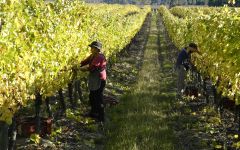Vina San Pedro 1865 Selected Vineyards Carmenere 2004


Product Details
Your Rating
Somm Note
Winemaker Notes
Aroma: Intense spices accompanied by soft green pepper, characteristic of this variety. There are toasted, vanilla, and smoke aromas from barrel aging.
Palate: This is a high-bodied wine, very gentle and rich, combining many flavors. It is highly complex and leaves a velvety, sweet sensation, with lots of tannins from the attack to the end.
Other Vintages
2020-
James
Suckling
-
James
Suckling -
Wine
Spectator
-
James
Suckling -
Wine
Enthusiast
-
James
Suckling
-
Wine
Spectator







Vina San Pedro was founded in 1865 in the Curico Valley by the Correa brothers. Today, more than 150 years later, it's still San Pedro's home valley. The brothers were pioneers in bringing different varieties from the Old Continent to the Valley.
San Pedro is now one of the most important vineyards in Chile and one of the top exporters, present in more than 80 countries around the world.
Also, San Pedro's Cachapoal Andes winery, home to the finest wines, is a place to discover the highest expression of Chileís diverse terroirs. Here, wines likes Altair, Cabo de Hornos and Sideral are made.
The Cachapoal Andes winery is located 110 km south of the city of Santiago, with vineyards at the foot of the Andes. Planted 500 meters above sea level, the vines are exposed to wide temperature variations between day and night, a peculiarity that allows the fruit to mature slowly, resulting in grapes with improved acidity, tannins, flavors, and aromatic profiles.

Dark, full-bodied and herbaceous with a spicy kick, Carménère found great success with its move to Chile in the mid-19th century. However, the variety went a bit undercover until 1994 when many plantings previously thought to be Merlot, were profiled as Carménère. Somm Secret— Carménère is both a progeny and a great-grandchild of the similarly flavored Cabernet Franc.

Dramatic geographic and climatic changes from west to east make Chile an exciting frontier for wines of all styles. Chile’s entire western border is Pacific coastline, its center is composed of warm valleys and on its eastern border, are the soaring Andes Mountains.
Chile’s central valleys, sheltered by the costal ranges, and in some parts climbing the eastern slopes of the Andes, remain relatively warm and dry. The conditions are ideal for producing concentrated, full-bodied, aromatic reds rich in black and red fruits. The eponymous Aconcagua Valley—hot and dry—is home to intense red wines made from Cabernet Sauvignon, Syrah and Merlot.
The Maipo, Rapel, Curicó and Maule Valleys specialize in Cabernet and Bordeaux Blends as well as Carmenère, Chile’s unofficial signature grape.
Chilly breezes from the Antarctic Humboldt Current allow the coastal regions of Casablanca Valley and San Antonio Valley to focus on the cool climate loving varieties, Pinot Noir, Chardonnay and Sauvignon Blanc.
Chile’s Coquimbo region in the far north, containing the Elqui and Limari Valleys, historically focused solely on Pisco production. But here the minimal rainfall, intense sunlight and chilly ocean breezes allow success with Chardonnay and Pinot Noir. The up-and-coming southern regions of Bio Bio and Itata in the south make excellent Riesling, Chardonnay and Pinot Noir.
Spanish settlers, Juan Jufre and Diego Garcia de Cáceres, most likely brought Vitis vinifera (Europe’s wine producing vine species) to the Central Valley of Chile sometime in the 1550s. One fun fact about Chile is that its natural geographical borders have allowed it to avoid phylloxera and as a result, vines are often planted on their own rootstock rather than grafted.
